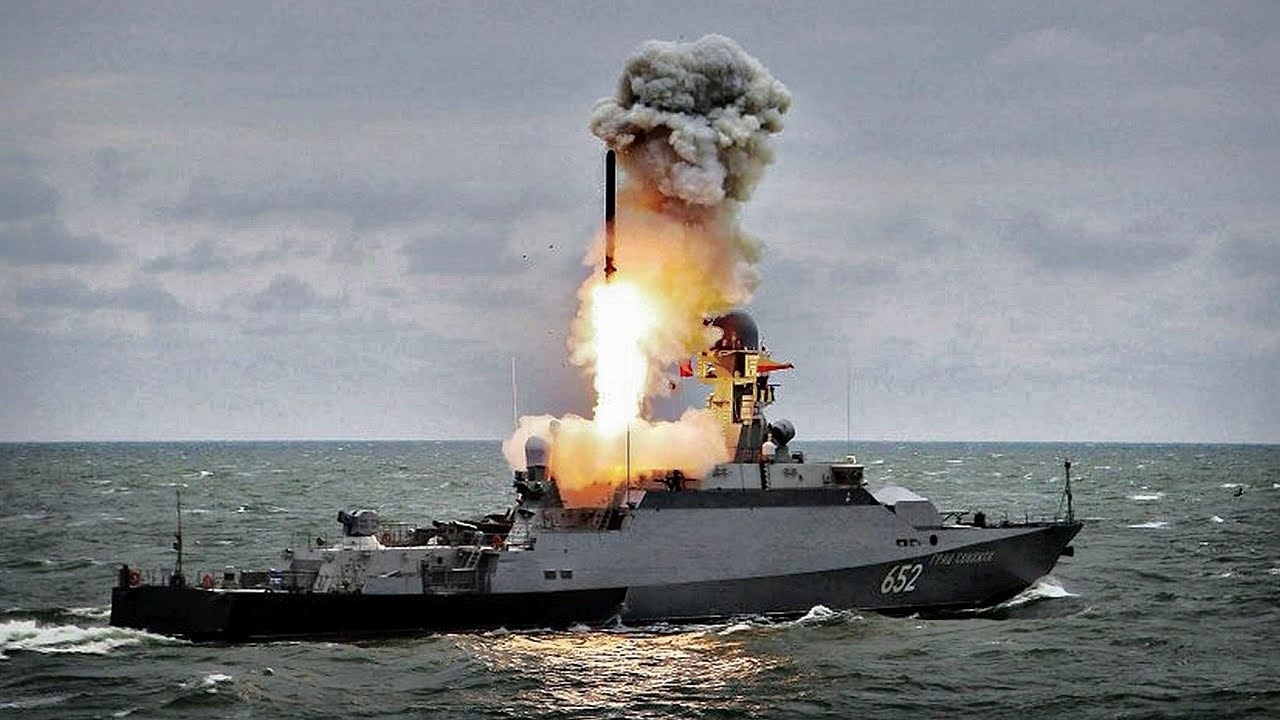Russian Navy Using Kalibr Cruise Missile for Ukrainian Bombardment: Since the beginning of the war, the Russian navy has sent volleys of Kalibr land-attack cruise missiles from ships and perhaps submarines from the Black Sea at targets in Ukraine. The Kalibr has a long-range and it is lethal and accurate. But the Ukrainians are responding with missile fire of their own that has damaged at least one Russian ship. The Vasily Bykov small patrol boat was reportedly hit by a Ukrainian missile fired from Odessa on March 7. If confirmed, this shows that the Russians have not destroyed all southern Ukrainian military targets with their navy. But the land-attack Kalibr will likely become a Russian go-to weapon during sieges in Kyiv or for targeting military targets in other parts of Ukraine.
Kalibr Able to Evade Enemy Defenses
The ship and submarine-launched Kalibr cruise missile hug the sea and then flies three times the speed of sound on its terminal approach. Unlike a ballistic missile, it flies low under enemy radar-guided by GPS and cameras. This makes it difficult for Ukrainian air defense systems to destroy as it is also maneuverable in flight. The Russians launched the cruise missile from the Caspian Sea at Syrian rebel targets that were 1,000 miles away beginning in 2015. In the Ukrainian war, the Russians fired it to soften defenses in the early phase of the conflict. The Russians launched at least 30-Kalibrs on February 24.
Russian Black Sea Fleet Features the Kalibr
In service since 2015, the Kalibr can be deployed on many different types of Russian ships as it has a common launch tube system. This makes even the smallest vessels such as corvettes or patrol ships much more dangerous to the Ukrainians. The Black Sea fleet is comprised of larger missile frigates and corvettes. The Kalibr has a range of 930 to 1,550 miles and employs a high-explosive warhead that weighs 990 pounds. The missile is 20-feet long.
Kalibrs can easily overpower Ukrainian defenses and even the Americans worry about Kalibrs that can ultimately be used against the U.S. Navy via Russian submarines.
According to a Congressional Budget Office report on Russian cruise missiles, “A raid consisting of many [land-attack cruise missiles] could overwhelm the American defenses. For example, a Yasen-class guided missile submarine in the Russian Navy can reportedly carry up to 32 3M-14 Kalibrs in its eight vertical launchers.”
Kalibrs may even be a cut above American Tomahawk cruise missiles. The Kalibr could also be nuclear-capable. The Kalibr will continue to damage or eliminate Ukrainian radar installations, command and control centers, and airfields in northern and eastern Ukraine.
Capable Against Many Different Types of Targets
The Kalibr can also go after similar installations in western Ukraine – giving the Russians a capability to deal with re-supply convoys that are coming from Poland by aiming for highways and bridges to halt the advance of Ukrainian logistics caravans.
The only thing stopping Kalibrs is their supply. Can the Russians keep their Black Sea fleet equipped with the cruise missile? The Russians control almost all of the ports along the Black Sea except for Odessa, which they are expected to attack in the coming weeks. Full control of the Ukrainian coast and the land bridge from Crimea to Russia can help the Russians re-supply the missiles.
The Ukrainians can only hope to use their own anti-ship missiles to destroy Russian vessels as best they can. However, the alleged attack on the Vasily Bykov was against a small ship operating close to shore. A Russian attack on Odessa will likely eliminate any shore-to-ship Ukrainian missiles.
Overall, the Kalibr is a tough customer. It is the Russian version of the Tomahawk and is highly versatile with many variants. The Ukrainians will ultimately find they have no defenses for it.
Now serving as 1945’s Defense and National Security Editor, Brent M. Eastwood, Ph.D., is the author of Humans, Machines, and Data: Future Trends in Warfare. He is an Emerging Threats expert and former U.S. Army Infantry officer. You can follow him on Twitter @BMEastwood.

